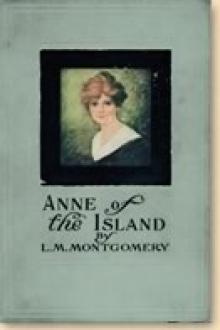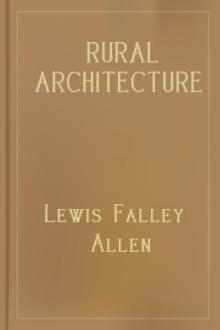A History of Art for Beginners and Students, Clara Erskine Clement Waters [best beach reads .txt] 📗

- Author: Clara Erskine Clement Waters
- Performer: -
Book online «A History of Art for Beginners and Students, Clara Erskine Clement Waters [best beach reads .txt] 📗». Author Clara Erskine Clement Waters
Two other Florentine artists of the same era with Fra Angelico were Masolino, whose real name was Panicale, and Tommaso Guidi, called Masaccio on account of his want of neatness. The style of these two masters was much the same, but Masaccio became so much the greater that little is said of Masolino. The principal works of Masaccio are a series of frescoes in the Brancacci Chapel in Florence. They represent “The Expulsion from Paradise,” “The Tribute Money,” “Peter Baptizing,” “Peter Curing the Blind and Lame,” “The Death of Ananias,” “Simon Magus,” and the “Resuscitation of the King’s Son.” There is a fresco by Masolino in the same chapel; it is “The Preaching of Peter.” Masaccio was in fact a remarkable painter. Some one has said that he seemed to hold Giotto by one hand, and reach forward to Raphael with the other; and considering the pictures which were painted before his time, his works are as wonderful as Raphael’s are beautiful. He died in 1429.
Paolo Uccello (1396-1479) and Filippo Lippi (1412-1469) were also good painters, and Sandro Botticelli (1447-1515), a pupil of Filippo, was called the best Florentine painter of his time. Fillipino Lippi (1460-1505) was a pupil of Botticelli and a very important artist. Andrea Verrocchio, Lorenzo di Credi, and Antonio Pollajuolo were all good painters of the Florentine school of the last half of the fifteenth century.
Of the same period was Domenico Ghirlandajo (1449-1494), who ranks very high on account of his skill in the composition of his works and as a colorist. He made his pictures very interesting also to those of his own time, and to those of later days, by introducing portraits of certain citizens of Florence into pictures which he painted in the Church of Santa Maria Novella and other public places in the city. He did not usually make them actors in the scene he represented, but placed them in detached groups as if they were looking at the picture themselves. While his scenes were laid in the streets known to us, and his architecture was familiar, he did not run into the fantastic or lose the picturesque effect which is always pleasing. Without being one of the greatest of the Italian masters Ghirlandajo was a very important painter. He was also a teacher of the great Michael Angelo.
Other prominent Florentine painters of the close of the fifteenth century were Francisco Granacci (1477-1543), Luca Signorelli (1441-1521), Benozzo Gozzoli (1424-1485), and Cosimo Rosselli (1439-1506).
Some good painters worked in Venice from the last half of the fourteenth century; but I shall begin to speak of the Venetian school with some account of the Bellini. The father of this family was Jacopo Bellini (1395-1470), and his sons were Gentile Bellini (1421-1507) and Giovanni Bellini (1426-1516).
The sketch-book of the father is one of the treasures of the British Museum. It has 99 pages, 17 by 13 inches in size, and contains sketches of almost everything—still and animal life, nature, ancient sculpture, buildings and human figures, stories of the Scriptures, of mythology, and of the lives of the saints are all illustrated in its sketches, as well as hawking parties, village scenes, apes, eagles, dogs, and cats. In this book the excellence of his drawing is seen; but so few of his works remain that we cannot judge of him as a colorist. It is certain that he laid the foundation of the excellence of the Venetian school, which his son Giovanni and the great Titian carried to perfection.
The elder son, Gentile, was a good artist, and gained such a reputation by his pictures in the great council-chamber of Venice, that when, in 1479, Sultan Mehemet, the conqueror of Constantinople, sent to Venice for a good painter, the Doge sent to him Gentile Bellini. With him he sent two assistants, and gave him honorable conduct in galleys belonging to the State. In Constantinople Gentile was much honored, and he painted the portraits of many remarkable people. At length it happened that when he had finished a picture of the head of John the Baptist in a charger, and showed it to the Sultan, that ruler said that the neck was not well painted, and when he saw that Gentile did not agree with him he called a slave and had his head instantly struck off, to prove to the artist what would be the true action of the muscles under such circumstances. This act made Gentile unwilling to remain near the Sultan, and after a year in his service he returned home. Mehemet, at parting, gave him many gifts, and begged him to ask for whatever would best please him. Gentile asked but for a letter of praise to the Doge and Signoria of Venice. After his return to Venice he worked much in company with his brother. It is said that Titian studied with Gentile: it is certain that he was always occupied with important commissions, and worked until the day of his death, when he was more than eighty years old.
By Gio. Bellini.
But Giovanni Bellini was the greatest of his family, and must stand as the founder of true Venetian painting. His works may be divided into two periods, those that were done before, and those after he learned the use of oil colors. His masterpieces, which can still be seen in the Academy and the churches of Venice, were painted after he was sixty-five years old. The works of Giovanni Bellini are numerous in Venice, and are also seen in the principal galleries of Europe. He did not paint a great variety of subjects, neither was his imagination very poetical, but there was a moral beauty in his figures; he seems to have made humanity as elevated as it can be, and to have stopped just on the line which separates earthly excellence from the heavenly. He often painted the single figure of Christ, of which Lübke says: “By grand nobleness of expression, solemn bearing, and an excellent arrangement of the drapery, he reached a dignity which has rarely been surpassed.” Near the close of his life he painted a few subjects which represent gay and festive scenes, and are more youthful in spirit than the works of his earlier years. The two brothers were buried side by side, in the Church of SS. Giovanni e Paolo, in Venice.
There were also good painters in Padua, Ferrara, and Verona in the fifteenth century.
Andrea Mantegna, of Padua (1430-1506), was a very important artist. He spent the best part of his life in the service of the Duke of Mantua; but his influence was felt in all Italy, for his marriage with the daughter of Jacopo Bellini brought him into relations with many artists. His services were sought by various sovereigns, whose offers he refused until Pope Innocent VIII. summoned him to Rome to paint a chapel in the Vatican. After two years there he returned to Mantua, where he died. His pictures are in all large collections; his finest works are madonnas at the Louvre, Paris, and in the Church of St. Zeno at Verona. Mantegna was a fine engraver also, and his plates are now very valuable.
In the Umbrian school Pietro Perugino (1446-1524) was a notable painter; he was important on account of his own work, and because he was the master of the great Raphael. His pictures were simple and devout in their spirit, and brilliant in color; in fact, he is considered as the founder of the style which Raphael perfected. His works are in the principal galleries of Europe, and he had many followers of whom we have not space to speak.
Francisco Francia (1450-1518) was the founder of the school of Bologna. His true name was Francisco di Marco Raibolini, and he was a goldsmith of repute before he was a painter. He was also master of the mint to the Bentivoglio and to Pope Julius II. at Bologna. It is not possible to say when he began to paint; but his earliest known work is dated 1490 or 1494, and is in the Gallery of Bologna. His pictures resemble those of Perugino and Raphael, and it is said that he died of sorrow because he felt himself so inferior to the great painter of Urbino. Raphael sent his St. Cecilia to Francia, and asked him to care for it and see it hung in its place; he did so, but did not live long after this. It is well known that these two masters were good friends and corresponded, but it is not certain that they ever met. Francia’s pictures are numerous; his portraits are excellent. Many of his works are still in Bologna.
In the Pitti Gallery, Florence.
We come now to one of the most celebrated masters of Italy, Leonardo da Vinci (1452-1519), the head of the Lombard or Milanese school. He was not the equal of the great masters, Michael Angelo, Raphael, and Titian; but he stands between them and the painters who preceded him or those of his own day.
In some respects, however, he was the most extraordinary man of his time. His talents were many-sided; for he was not only a great artist, but also a fine scholar in mathematics and mechanics; he wrote poetry and composed music, and was with all this so attractive personally, and so brilliant in his manner, that he was a favorite wherever he went. It is probable that this versatility prevented his being very great in any one thing, while he was remarkable in many things.
When still very young Leonardo showed his artistic talent. The paper upon which he worked out his sums was frequently bordered with little pictures which he drew while thinking on his lessons, and these sketches at last attracted his father’s attention, and he showed them to his friend Andrea Verrocchio, an artist of Florence, who advised that the boy should become a painter. Accordingly, in 1470, when eighteen years old, Leonardo was placed under the care of Verrocchio, who was like a kind father to his pupils: he was not only a painter, but also an architect and sculptor, a musician and a geometer, and he especially excelled in making exquisite cups of gold and silver, crucifixes and statuettes such as were in great demand for the use of the priesthood in those days.
In the Royal Library, Turin.
Pietro Perugino was a fellow-pupil with Leonardo, and they two soon surpassed their master in painting, and at last, when Verrocchio was painting a picture for the monks of Vallambrosa, and desired Leonardo to execute an angel in it, the work of his pupil was so much better than his own that the old painter desired to throw his brush aside forever. The picture is now in the Academy of Florence, and represents “The Baptism of Christ.” With all his refinement and sweetness, Leonardo had a liking for the horrible. It once happened that a countryman brought to his father a circular piece of wood cut from a fig-tree, and desired to have it painted for a shield; it was handed over to Leonardo, who collected in his room a number of lizards, snakes, bats, hedgehogs, and other frightful creatures, and from these painted an unknown monster having certain characteristics of the horrid things he had about him. The hideous creature was surrounded by fire, and was breathing out flames. When his





Comments (0)